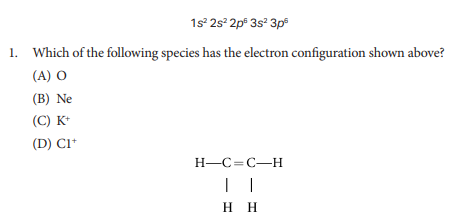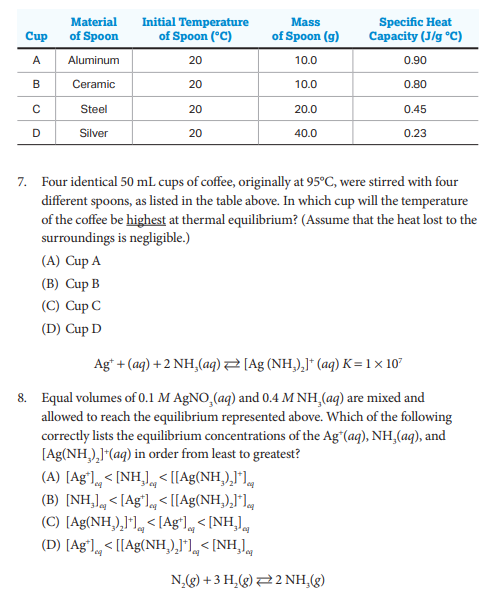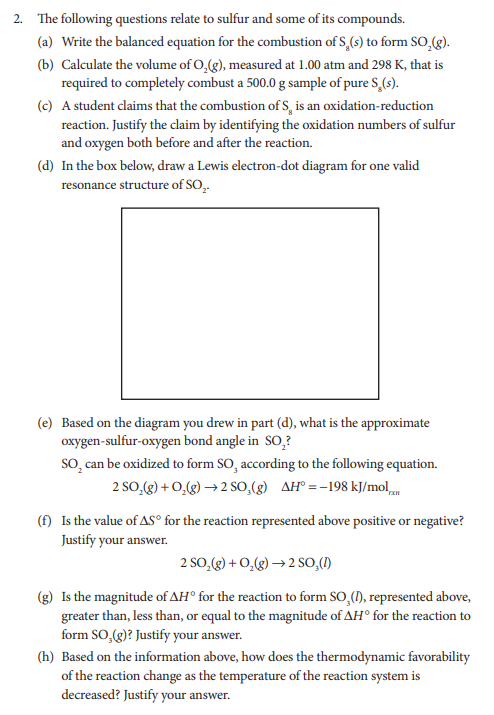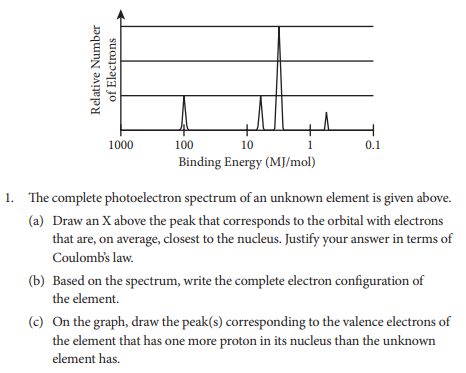Ultimate Guide to the AP Chemistry Exam
The AP Chemistry exam is one of the more common exams taken among self-studiers and enrolled students alike. In 2019, roughly 150,000 of the more than 5 million students taking AP exams took the AP Chemistry exam. If you are interested in taking the AP Chemistry exam, whether you have taken the class or self-studied, read on for a breakdown of the test and CollegeVine’s advice for how to best prepare for it. The 2020 AP Exams have been changed to online exams due to coronavirus. Learn about these changes in our post How is Coronavirus Impacting AP Exams? The AP Chemistry course focuses on developing your advanced inquiry and reasoning skills, such as designing a plan for data collection, analysis of data, application of mathematical routines, and building connections between concepts across domains. Because the base of scientific knowledge is so rapidly expanding through discovery and research, the AP Chemistry course, much like AP Biology, focuses on your mastery of lasting conceptual understandings within the field, and the specific content that supports them. The prerequisites for AP Chemistry are Algebra II and a general high school chemistry course. If you have not taken these classes before enrolling or undertaking self-study, you are not likely to be prepared for the level of thinking required for success on the AP Chemistry exam. There are two main components of the AP Chemistry exam: scientific practices and course content. Scientific practices are the skills needed to think like a chemist, while course content encompasses the abstract concepts or themes that are the foundation of the course. Course content is further broken down into “Big Ideas.” The AP Chemistry exam consists of six science practices: phenomena a single scale or across multiple scales scientific argument There are four big ideas covered by the AP Chemistry exam, those are: While taking the AP Chemistry exam, you may use a scientific calculator on the free-response section only. You will also be provided with an equation and formula list and a copy of the periodic table. A complete list of calculator guidelines and acceptable models can be found in the College Board’s Calculator Policy. A copy of the equations and formula list supplied on the exam can be found in the appendix of the official AP Chemistry course and exam description. The AP Chemistry course is divided into nine units. Below is a suggested sequence of the units from the College Board, along with the percentage each unit accounts for on the multiple-choice section of the AP Chemistry exam. The AP Chemistry exam is one of the longer AP exams, clocking in at three hours and fifteen minutes. It consists of two sections—the first section contains multiple-choice questions, while the second section is made up of free-response questions. Section 1: Multiple Choice 1 hour and 30 minutes | 60 questions | 50% of score The first section of the AP Chemistry exam contains 60 multiple choice questions—both in sets and stand-alone—that you have 90 minutes to answer. To score well on this section of the exam, students must be able to: Sample of a stand-alone multiple-choice question: Answer: C Sample of a set of multiple-choice questions: Answers – 7: B, 8: D Section 2: Free Response 1 hour 45 minutes | 7 questions | 50% of score The free-response section of the AP Chemistry exam is divided into three long essays (worth 10 points each) and four short-response answers (worth four points each). You are allowed to use a scientific or graphing calculator on the entire free-response section of the exam. (A four-function calculator is allowed but not recommended.) It will be up to you to budget your time on this section, as your proctor will remind you of time remaining, but will not force you to move on to the next question at any point. Example of a long essay question: Example of a short-response question: The AP Chemistry exam is a tough one to master, though many students do well enough to pass (which typically means earning a score of 3 or higher). In 2019, 55.6% of students who took the AP Chemistry exam received a score of 3 or higher. Of these, only 11.5% of students received the top score of 5 with another 16.6% scoring a 4. A little over a quarter of all test-takers received a score of 3, contributing greatly to the exam’s pass rate. Roughly another quarter of students received a score of 2, while 21.4% of test-takers scored a 1 on the exam. Keep in mind, credit and advanced standing based on AP scores varies widely from school to school. Though a score of 3 is typically considered passing, it is not always enough to receive credit. Regulations regarding which APs qualify for course credits or advanced placement at specific colleges and universities can be found on the College Board website. A full course description that can help to guide your studying and understanding of the knowledge required for the exam can be found in the College Board course description. Read on for tips for preparing for the exam. A smart first step is to take a practice test to get a better idea of your strengths and weaknesses in the course curriculum. Although the College Board AP Chemistry website provides a number of sample test questions and exam tips, it does not provide a complete practice test. In fact, because the exam was recently redesigned, it is difficult to find updated practice tests. There is one updated practice exam from fall 2008 available here. Other than that, your best bet may be to use those provided in one of the many up-to-date commercial study guides. Once you have taken some kind of formative assessment, score it to identify the areas you already understand and those in need of improvement. It can be helpful to have a friend or teacher score your free-response essays, as these are more subjective than the multiple-choice section. From an accurate formative assessment, you will get a better idea of where to focus your studying efforts. In order to understand the material in the AP Chemistry course, the course’s four “big ideas.” This comprehension should include each of the “enduring understandings” (falling under each big idea,) and examples of essential knowledge to support them. The big ideas encompass core scientific principles, theories, and processes that “provide a broad way of thinking about the particulate nature of matter.” The ability to apply big ideas across the nine units of the AP Chemistry exam is vital to achieving a passing score. You will also need to master six scientific practices of the AP Chemistry course. To reinforce the six scientific practices and their practical applications, you should be familiar with the AP Chemistry Lab Manual. If this manual is not included as part of your course materials, you may purchase one here. For a more specific idea of where to focus your studying, you may consider using an updated commercial study guide. The Princeton Review’s Cracking the AP Chemistry Exam, 2020 Premium Edition: 5 Practice Tests + Complete Content Review provides a comprehensive guide to the exam, though it is sometimes criticized for its lengthy descriptions of content. Another solid choice is the AP Chemistry Crash Course, For the 2020 Exam, Book + Online: Get a Higher Score in Less Time (Advanced Placement (AP) Crash Course), Third Edition, which provides a more concise summary of content and is often praised for its specific study tips. There are also a number of free study resources available online. Many AP teachers have posted complete study guides, review sheets, and test questions. Mr. Baruch’s website (a teacher from Carmel High School in Carmel, New York) and Mr. Allan’s website (a retired high school science teacher) are both excellent starting points. Another convenient way to study is to use one of the apps developed for AP exams. Make sure you read reviews before choosing one—their quality varies widely. Varsity Tutors has an AP Chemistry app that is highly-rated. This may seem like a lot to absorb at first glance, but remember: if you pace yourself, you can easily tackle this material in small chunks over the course of the school year. Once you have your theory down, test it out by practicing multiple-choice and grid-in questions. The multiple-choice questions from the 2002 AP Chemistry exam are available online. You’ll also find 58 free AP Chemistry test review questions on PracticeQuiz.com and another 50 on Study.com. You could also try taking the multiple-choice section of another practice exam. The College Board provides a set of strategies and tips for multiple-choice questions on its AP Chemistry Exam Tips page. The College Board Course Description includes many practice multiple-choice questions along with explanations of their answers. As you go through these, try to keep track of which areas are still tripping you up, and go back over this theory again. Focus on understanding what each question is asking and keep a running list of any concepts that are still unfamiliar. The free-response section of the AP Chemistry exam emphasizes solving in-depth problems and writing essays where knowledge of which principles to apply and how to apply them is the most important aspect of the solution. Pay close attention to the task verbs used in the free-response essay prompts. On the AP Chemistry exam, these most commonly include: justify, explain, predict, or describe. Know precisely what each one of these words is asking you to do. Underline each section of the question, circle the task verb, and check them off as you write. Many students lose points by simply forgetting to include one part of a multipart question. As you complete the free-response questions, make sure to keep an eye on the time. Though you will be reminded of time remaining by the exam proctor, you will not be forced to move on to another question. Remember, you should spend roughly 20-25 minutes on each long answer and 3-10 minutes on each short answer. Make sure you stay on track to address each section of every question. No points can be awarded for answers left completely blank when time runs out. The College Board has the free-response questions used on the AP Chemistry exam dating back to 2014 posted on their website along with commentary from the scorers. These are perfect to practice for the free-response section of the AP Chemistry exam, along with getting an in-depth understanding of the types of answers the College Board is looking for. Take another practice test to assess your knowledge—Varsity Tutors has a deep library of free diagnostic tests if you need one. You should see steady improvement and be able to pinpoint existing areas of weakness. If possible, repeat the above steps to incrementally increase your score. If you’re taking the AP course associated with this exam, your teacher will walk you through how to register. If you’re self-studying, check out our blog post How to Self-Register for AP Exams. For information about what to bring to the exam, see our post What Should I Bring to My AP Exam (And What Should I Definitely Leave at Home)? Curious about your chances of acceptance to your dream school? When you create your free CollegeVine account, you gain access to our data-driven chancing engine—providing you with a calculation of your real admissions chances, a best-fit school list, and insight into how you can improve your profile. Sign up for your CollegeVine account today and get a headstart on your college journey! For more guidance about the AP exams, check out these other informative articles: When is the AP Chemistry Exam?
About the AP Chemistry Exam
Skill
Description
Percentage of
Exam Score (Multiple-Choice Section)
Percentage of
Exam Score (Free-Response Section)
Models and Representations
Describe models and representations, including across scales
8%-12%
2%–4%
Question and Method
Determine scientific questions and methods
8%-12%
10%-16%
Representing Data and Phenomena
Create representations or models of chemical
8%-16%
Model Analysis
Analyze and interpret models and representations on
23%-30%
23%-30%
Mathematical Routines
Solve problems using mathematical relationships
35%-42%
43%53%
Argumentation
Develop an explanation or
8%-12%
15%-24%
Skill
Description
Scale, Proportion, and Quantity
Understanding the meaning of the macroscopic and atomic scale, and the relationship between quantities at the same scale and across scales
Structure and Properties
Using observed properties to infer aspects of the structures and interactions of atoms and molecules
Transformations
Understanding the details of transformations occurring both acroscopically and at the atomic level
Energy
Energy’s role in characterizing and controlling chemical systems
AP Chemistry Course Content
AP Chemistry Unit
Description
Percentage of Exam Score (Multiple-Choice Section)
Atomic Structure and Properties
Learn about the composition of atoms and ways scientists measure and categorize these molecular building blocks
7%–9%
Molecular and Ionic Compound Structure
and Properties
Discover the range of chemical bonds and how their structure can affect the properties of the molecules created
7%–9%
Intermolecular Forces
and Properties
Explore how atoms come together to create solids, liquids, and gases, and how subatomic forces govern the properties of everything around you
18%–22%
Chemical Reactions
Learn how to differentiate physical and chemical processes, and how to measure and express chemical reactions via chemical equations
7%–9%
Kinetics
Explore various methods to observe the changes that occur during a chemical reaction and the effects of a series of reactions
7%–9%
Thermodynamics
Learn about energy changes in chemical reactions and how a transfer of energy can change a substance’s physical qualities
7%–9%
Principles of Equilibrium
Chart how chemical reactions change over time, what causes substances to reach equilibrium, and how systems react when that equilibrium is disturbed
7%–9%
Acids and Base
Learn more about pH, the qualities and properties of acids and bases, and how they interact in chemical reactions
11%–15%
Applications of Thermodynamics
An introduction to the concept of “thermodynamic favorability” for reactions, meaning how likely they are to occur given energy changes and environmental factors
7%–9%
AP Chemistry Exam Content




AP Chemistry Score Distribution, Average Score, and Passing Rate
Exam
5
4
3
2
1
AP Chemistry
11.5%
16.6%
27.52%
23%
21.4%
Best Ways to Study for the AP Chemistry Exam
Step 1: Assess Your Skills
Step 2: Study the Material
Step 3: Practice Multiple-Choice Questions
Step 4: Practice Free-Response Questions
Step 5: Take Another Practice Test
Step 6: Exam Day Specifics





